+ Open data
Open data
- Basic information
Basic information
| Entry | Database: PDB / ID: 8hdt | ||||||
|---|---|---|---|---|---|---|---|
| Title | Cyanophage Pam3 capsid asymmetric unit | ||||||
 Components Components |
| ||||||
 Keywords Keywords | VIRAL PROTEIN / capsid asymmetric unit / VIRUS | ||||||
| Biological species |  uncultured cyanophage (environmental samples) uncultured cyanophage (environmental samples) | ||||||
| Method | ELECTRON MICROSCOPY / single particle reconstruction / cryo EM / Resolution: 3.17 Å | ||||||
 Authors Authors | Yang, F. / Jiang, Y.L. / Zhou, C.Z. | ||||||
| Funding support |  China, 1items China, 1items
| ||||||
 Citation Citation |  Journal: Proc Natl Acad Sci U S A / Year: 2023 Journal: Proc Natl Acad Sci U S A / Year: 2023Title: Fine structure and assembly pattern of a minimal myophage Pam3. Authors: Feng Yang / Yong-Liang Jiang / Jun-Tao Zhang / Jie Zhu / Kang Du / Rong-Cheng Yu / Zi-Lu Wei / Wen-Wen Kong / Ning Cui / Wei-Fang Li / Yuxing Chen / Qiong Li / Cong-Zhao Zhou /  Abstract: The myophage possesses a contractile tail that penetrates its host cell envelope. Except for investigations on the bacteriophage T4 with a rather complicated structure, the assembly pattern and tail ...The myophage possesses a contractile tail that penetrates its host cell envelope. Except for investigations on the bacteriophage T4 with a rather complicated structure, the assembly pattern and tail contraction mechanism of myophage remain largely unknown. Here, we present the fine structure of a freshwater cyanophage Pam3, which has an icosahedral capsid of ~680 Å in diameter, connected via a three-section neck to an 840-Å-long contractile tail, ending with a three-module baseplate composed of only six protein components. This simplified baseplate consists of a central hub-spike surrounded by six wedge heterotriplexes, to which twelve tail fibers are covalently attached via disulfide bonds in alternating upward and downward configurations. In vitro reduction assays revealed a putative redox-dependent mechanism of baseplate assembly and tail sheath contraction. These findings establish a minimal myophage that might become a user-friendly chassis phage in synthetic biology. | ||||||
| History |
|
- Structure visualization
Structure visualization
| Structure viewer | Molecule:  Molmil Molmil Jmol/JSmol Jmol/JSmol |
|---|
- Downloads & links
Downloads & links
- Download
Download
| PDBx/mmCIF format |  8hdt.cif.gz 8hdt.cif.gz | 530.3 KB | Display |  PDBx/mmCIF format PDBx/mmCIF format |
|---|---|---|---|---|
| PDB format |  pdb8hdt.ent.gz pdb8hdt.ent.gz | 445.2 KB | Display |  PDB format PDB format |
| PDBx/mmJSON format |  8hdt.json.gz 8hdt.json.gz | Tree view |  PDBx/mmJSON format PDBx/mmJSON format | |
| Others |  Other downloads Other downloads |
-Validation report
| Summary document |  8hdt_validation.pdf.gz 8hdt_validation.pdf.gz | 1.7 MB | Display |  wwPDB validaton report wwPDB validaton report |
|---|---|---|---|---|
| Full document |  8hdt_full_validation.pdf.gz 8hdt_full_validation.pdf.gz | 1.7 MB | Display | |
| Data in XML |  8hdt_validation.xml.gz 8hdt_validation.xml.gz | 105 KB | Display | |
| Data in CIF |  8hdt_validation.cif.gz 8hdt_validation.cif.gz | 147.7 KB | Display | |
| Arichive directory |  https://data.pdbj.org/pub/pdb/validation_reports/hd/8hdt https://data.pdbj.org/pub/pdb/validation_reports/hd/8hdt ftp://data.pdbj.org/pub/pdb/validation_reports/hd/8hdt ftp://data.pdbj.org/pub/pdb/validation_reports/hd/8hdt | HTTPS FTP |
-Related structure data
| Related structure data |  34680MC 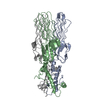 7yfwC 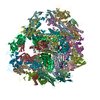 7yfzC 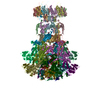 8hdrC 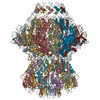 8hdsC 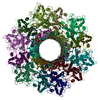 8hdwC M: map data used to model this data C: citing same article ( |
|---|
- Links
Links
- Assembly
Assembly
| Deposited unit | 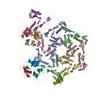
|
|---|---|
| 1 |
|
- Components
Components
| #1: Protein | Mass: 34143.984 Da / Num. of mol.: 7 / Source method: isolated from a natural source Source: (natural)  uncultured cyanophage (environmental samples) uncultured cyanophage (environmental samples)#2: Protein | Mass: 17210.295 Da / Num. of mol.: 7 / Source method: isolated from a natural source Source: (natural)  uncultured cyanophage (environmental samples) uncultured cyanophage (environmental samples) |
|---|
-Experimental details
-Experiment
| Experiment | Method: ELECTRON MICROSCOPY |
|---|---|
| EM experiment | Aggregation state: PARTICLE / 3D reconstruction method: single particle reconstruction |
- Sample preparation
Sample preparation
| Component | Name: uncultured cyanophage / Type: VIRUS / Entity ID: all / Source: NATURAL |
|---|---|
| Source (natural) | Organism:  uncultured cyanophage (environmental samples) uncultured cyanophage (environmental samples) |
| Details of virus | Empty: NO / Enveloped: NO / Isolate: OTHER / Type: VIRION |
| Natural host | Organism: Pseudanabaena mucicola |
| Buffer solution | pH: 7.5 |
| Specimen | Embedding applied: NO / Shadowing applied: NO / Staining applied: NO / Vitrification applied: YES |
| Vitrification | Cryogen name: ETHANE / Humidity: 100 % / Chamber temperature: 300 K |
- Electron microscopy imaging
Electron microscopy imaging
| Experimental equipment |  Model: Titan Krios / Image courtesy: FEI Company |
|---|---|
| Microscopy | Model: FEI TITAN KRIOS |
| Electron gun | Electron source:  FIELD EMISSION GUN / Accelerating voltage: 300 kV / Illumination mode: SPOT SCAN FIELD EMISSION GUN / Accelerating voltage: 300 kV / Illumination mode: SPOT SCAN |
| Electron lens | Mode: BRIGHT FIELD / Nominal defocus max: 2000 nm / Nominal defocus min: 1000 nm |
| Image recording | Electron dose: 50 e/Å2 / Film or detector model: GATAN K2 SUMMIT (4k x 4k) |
- Processing
Processing
| EM software | Name: RELION / Version: 3.1 / Category: 3D reconstruction |
|---|---|
| CTF correction | Type: PHASE FLIPPING ONLY |
| 3D reconstruction | Resolution: 3.17 Å / Resolution method: FSC 0.143 CUT-OFF / Num. of particles: 130253 / Symmetry type: POINT |
 Movie
Movie Controller
Controller








 PDBj
PDBj